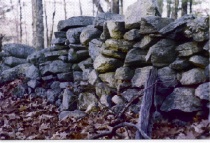
The SWI was co-founded by Robert M. Thorson and Kristine Thorson in May 2002 prior to publication of Stone by Stone: The Magnificent History In New England Stone Walls. Our goal was to create a forum for readers to share their thoughts about this book with the author and each other, and to draw attention to the concurrent educational efforts associated with Stone Wall Secrets. At the time, the first iPhones were still years away, and internet access from home was via a dial-up modem. To get the SWI online, I wrote HTML code using then-expensive software, the visual editor “Dreamweaver.” All early photos were by rolls of film sent out for chemical development.
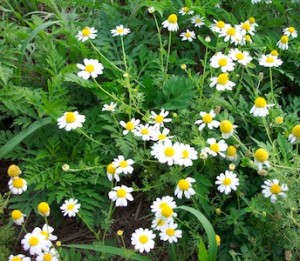
Shortly after we went on-line, hundreds of local residents of Mansfield CT (where I lived) received a bulk-mail solicitation from a stone dealer in Belchertown, MA asking if we would sell our stone walls for a quoted price. In effect, he was asking for permission to strip mine walls from our rural landscape for shipment elsewhere. We were outraged. Almost overnight, the SWI went into high gear as a grass roots (actually “stone roots”) advocacy organization devoted to stone wall conservation throughout the region. Knowing that a conservation ethic is most successful when taught to children, Kristine, my children, their teachers, my colleagues, and ramped up our effort in public schools using using Stone Wall Secrets. When combined, these activities –books, website, public appearances, classroom visits, etc.– became a focal point for the effort to preserve our rural landscape.
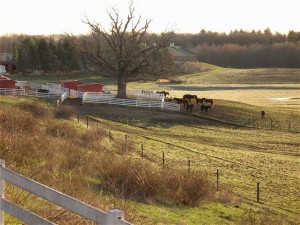
During its early years (2002-2008), thousands of individuals and organizations contacted the SWI by phone, letter, email or just walking into it actual office on Horsebarn Hill Road in Storrs, CT. Thousands more heard my hundreds of lectures, or attended my guided hikes and workshops for community groups, annual meetings, schools , and conventions (Link to the E-Archive page of the SWI for an extended example). Many more read articles and reviews in newspapers and magazines, saw the work of the SWI on television, or heard it on NPR radio affiliates. A film company (Illusion Films) even made a movie, Passages of Time, which chronicled the regional effort, and which is no longer available for purchase. A copy o fthe original CD is available in UConn’s archive.
Because SWI never had a budget, and because I am slow to adapt to technologic change, it took me three full years to get an email newsletter out to what was then a growing list-serve of nearly five hundred people from all over the country. The next year, I mailed out a hard-copy letter to that group that included copies of important articles, passing the costs to UCONN.
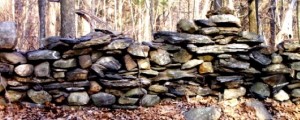
Midway through this effort, I wrote Exploring Stone Walls: A Field Guide to New England’s Stone Walls (Walker, 2005). This book was written to answer at one time the thousands of questions I had been asked by stone wall enthusiasts in the preceding three years. The book’s purpose was: (1) to lay the groundwork for a science of stone walls; (2) to provide a language for describing and classifying walls for the purpose of inventory and management, and (3) to enhance the New England culture-tourism economy.
To strengthen its public outreach and archival efforts, and because of close ties to the Office of the State Archaeologist, the SWI merged with the Connecticut State Museum of Natural History in the spring of 2005. For a while, there was a physical office, located in the Office of the State Archaeologist. And during this stage, there was also an official linkage with a long-term educational initiative, the Teachers for a New Era Project (TNE) at the University of Connecticut, which was funded by the Carnegie Institution of New York. This collaboration led to a two-year curriculum project in 2006 based on Stone Wall Secrets, funded by the National Science Foundation, and carried out with support of colleagues David Moss and Wendy Glen of the NEAG School of Education at UConn.
Beginning about 2007, I shifted much of my non-teaching attention away from stone walls and towards the glacial kettle lakes and ponds decorating the northern United States from Nantucket Island to Great Falls Montana. Though the SWI continued through these years, it took a backseat to my work on lakes resulting in Beyond Walden: The Hidden History of America’s Kettle Lakes and Ponds (Blomsbury, 2009). This work sent me in the direction of Henry D. Thoreau scholarlship, with 2 books for Harvard University press, the first guide to Walden Pond, and now a book in process for Princeton Press. Since then I’ve maintained
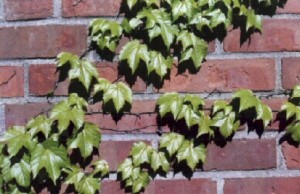
Between 2019 and present my work on stone walls has picked up again. Most important is the publication of a peer-reviewed, 31-page mini-monograph establishing the science of stone walls as a field discipline in Historical Archaeology with Taxonomy and Nomenclature of the Stone Domain in New England. Another important, related effort was to publish an extended essay in Smithsonian on the historical and cultural significance of stone walls.